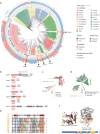Discovering CRISPR-Cas system with self-processing pre-crRNA capability by foundation models
- PMID: 39562558
- PMCID: PMC11576732
- DOI: 10.1038/s41467-024-54365-0
Discovering CRISPR-Cas system with self-processing pre-crRNA capability by foundation models
Erratum in
-
Author Correction: Discovering CRISPR-Cas system with self-processing pre-crRNA capability by foundation models.Nat Commun. 2025 Jan 9;16(1):535. doi: 10.1038/s41467-025-55913-y. Nat Commun. 2025. PMID: 39789054 Free PMC article. No abstract available.
Abstract
The discovery of CRISPR-Cas systems has paved the way for advanced gene editing tools. However, traditional Cas discovery methods relying on sequence similarity may miss distant homologs and aren't suitable for functional recognition. With protein large language models (LLMs) evolving, there is potential for Cas system modeling without extensive training data. Here, we introduce CHOOSER (Cas HOmlog Observing and SElf-processing scReening), an AI framework for alignment-free discovery of CRISPR-Cas systems with self-processing pre-crRNA capability using protein foundation models. By using CHOOSER, we identify 11 Casλ homologs, nearly doubling the known catalog. Notably, one homolog, EphcCasλ, is experimentally validated for self-processing pre-crRNA, DNA cleavage, and trans-cleavage, showing promise for CRISPR-based pathogen detection. This study highlights an innovative approach for discovering CRISPR-Cas systems with specific functions, emphasizing their potential in gene editing.
© 2024. The Author(s).
Conflict of interest statement
Figures





References
-
- Wang, J. Y. & Doudna, J. A. CRISPR technology: a decade of genome editing is only the beginning. Science379, eadd8643 (2023). - PubMed
Publication types
MeSH terms
Substances
Associated data
LinkOut - more resources
Full Text Sources

